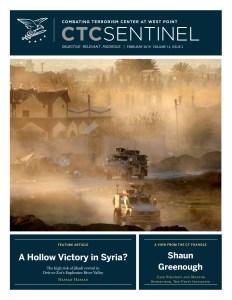From the Editor
In Syria, the Islamic State has now been reduced to a few vanishing pockets in Deir ez-Zor’s Middle Euphrates River Valley as a result of two separate military offensives on opposite sides of the river by Kurdish-led Syrian Democratic Forces (SDF) and forces loyal to the Assad regime. But while Deir ez-Zor has now been essentially liberated from the Islamic State, securing and stabilizing the region will likely prove much harder. In our cover article, Hassan Hassan writes the “long period it took the overstretched SDF to liberate the east side of the Euphrates afforded the Islamic State time to create sleeper cells.” He argues the fact that the west side is again under Assad regime control will likely provide opportunities to both the Islamic State and the al-Qa`ida offshoot Hayat Tahrir al-Sham to tap into local Sunni anger to rebuild their operations. Hassan warns there will be even more opportunities for jihadis to rebound if the Assad regime exploits what will likely be a vacuum left by soon-to-depart U.S. forces to take control of the areas liberated by the SDF. All this, he warns, creates a very real risk that the border region between Syria and Iraq could emerge as a long-term threat to global security, just like the border area between Pakistan and Afghanistan after the fall of the Taliban.
Our interview is with Shaun Greenough, the Case Strategy and Mentor Supervisor at The Unity Initiative (TUI), a specialist intervention consultancy based in the United Kingdom that focuses on rehabilitating individuals convicted of terrorist offenses and tackling absolutist mindsets in the wider community. Greenough previously served in a variety of counterterrorism roles including managing aspects of the U.K. police investigation into the 2006 transatlantic airline plot.
Major Stephen Hummel, Colonel F. John Burpo, and Brigadier General James Bonner, the Commanding General of the U.S. Army’s 20th CBRNE Command, warn there is a high risk that profit-minded suppliers within vast, transnational IED networks may in the future expand into WMD proliferation. They write “the convergence of these two seemingly separate networks does not mean that an IED facilitation network will suddenly market WMD, rather that non-state actors could employ these networks to gather the knowledge, people, materials, finances, and infrastructure required for WMD development and employment.” Ross Dayton assesses the threat posed by the ELN terrorist group, which in January 2019 carried out an apparent suicide bombing on the national police academy in Bogotá, Colombia, that killed over 20 police cadets. “The ELN now operates in 12 Venezuelan states with virtual impunity under the Maduro government,” he writes, allowing “ELN fighters to escape the jurisdiction of Colombian security forces and exploit opportunities for illicit financing and recruitment.”
Paul Cruickshank, Editor in Chief
 Skip to content
Skip to content

